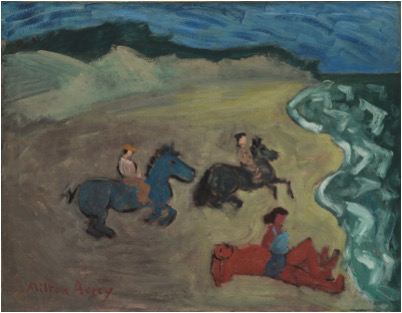
Milton Avery
American, 1893-1965
Beach Riders, 1941
oil on canvas
28 x 36 in.
SBMA, Gift of Leatrice Luria, Trustee of the Survivor Trust under the Luria Family Trust
1997.28

In order to paint one has to go by the way one does not know. Art is like turning corners: one never knows what is around the corner until one has made the turn.
— Milton Avery, as quoted in Burt Chernow, Milton Avery Drawings, 1973
COMMENTS
Depicting everyday scenes of domestic, city, and country life, painter and printmaker Milton Avery favored simplified forms and the flat application of color, inspired by Henri Matisse and Pablo Picasso. “I try to construct a picture in which shapes, spaces, [and] colors form a set of unique relationships, independent of any subject matter,” he once said. Avery’s early work incorporated elements of Impressionism, but his smooth planes of color and combination of figuration and abstraction would make him an archetype of American Modernism, prefiguring aspects of Color Field painting by years. Avery was a friend and source of inspiration to artists including Mark Rothko, Adolph Gottlieb, and Barnett Newman. A man of few words, he was said to have frequently quipped, “Why talk when you can paint?”
Milton Avery was born at Sand Bank, New York, today known as Altmar, on 7 March 1893. After studying for a while at the Connecticut League of Art Students in Hartford under Charles Noel Flagg and at the Art Society School there under Albertus Jones, Avery worked in manufacturing and with an insurance company until 1924. He moved to New York in 1925 and married the artist Sally Michel, an illustrator, a year later.
He had his first one-man show as early as 1928 at the Opportunity Gallery in New York. The decades that followed saw him show work at numerous exhibitions mounted by New York galleries and American museums. Milton Avery's preoccupation with French Fauvism and German Expressionism led him to develop a simplified formal idiom distinguished by clarity of line and an expressive palette. Whereas Avery's early figurative drawings and paintings from the 1930s attest to affinities primarily with the work of Ernst Ludwig Kirchner, by the 1940s he was discernibly close to Henri Matisse.
As the American upholder of Matisse's colouristic doctrine, Milton Avery developed the French artist's decorative color surfaces into subtly toned colour zones, thus breaking the ground for the Colour Field painting of Mark Rothko and Adolph Gottlieb, both of whom were friends of his. Even though his style was close to abstraction, Milton Avery nonetheless clung to representation throughout his entire career. Classical motifs and subject matter in portraits, still lifes and coastal landscapes were his main thematic areas and genres.
Prolific as a painter, graphic artist and ceramist, Milton Avery received numerous awards from American art institutions before he died in 1965 although he only really became famous posthumously. Now he is acclaimed as one of the most influential US 20th-century artists.
Art Directory
SBMA CURATORIAL LABELS
The art of Milton Avery is now recognized for its anticipation of the advanced abstraction associated with the likes of Adolph Gottlieb and Mark Rothko, who both acknowledged their indebtedness to his example. Avery famously stood apart from the trends of the New York art world, preferring to develop his own idiosyncratic approach to shape, color, and line. This painting exhibits the deliberate gaucherie, high-keyed palette, and studied naiveté typical of Avery, in part inspired by Henri Matisse and the Fauves. The flat figures appear as collaged elements on the surface, while the overt absence of perspective and repeated curvilinear and arrow-shaped notational lines convey the idea of movemented waves and galloping horses, rather than their illusion.
- Highlights of American Art, 2020
